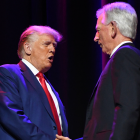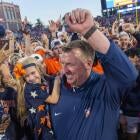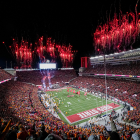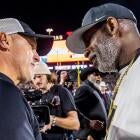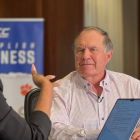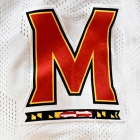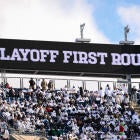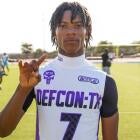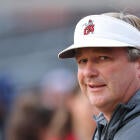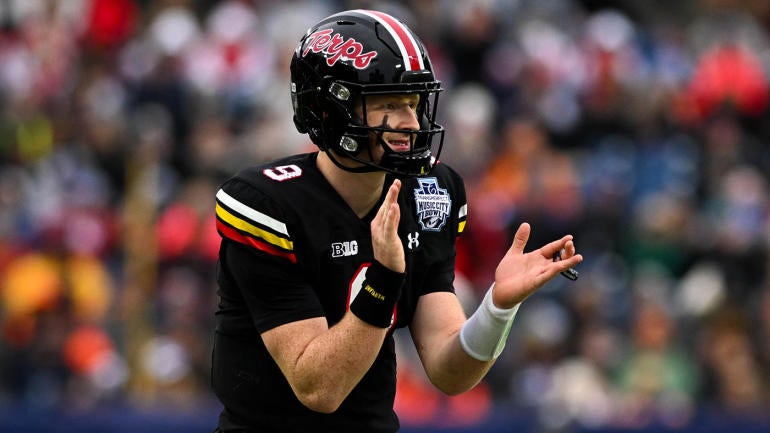
For all of college football's big box office, bluster and billions, Alex Shada saw a financial opportunity two years ago at the Senior Bowl. The head of GSC, a well-known company in football circles based in little-known Wahoo, Nebraska, had been supplying coach-to-player helmet communications to the NFL for the last decade.
This was Shada's moment of realization. Here before him that day were some of the best and brightest quarterbacks jockeying for attention at the nation's oldest college all-star game. And they looked helpless.
The market for his products was about to take off like a go route.
"The first day of practice, they have an NFL coach talking to [college quarterbacks] in their helmets instead of getting a signal from the sideline," Shada said. "I watched an NFL coach, after about the fifth play, just screaming at these guys. Pretty colorful words. 'If you guys think you're going to make it in the NFL, you better get your poop in a group.'
"One of the [other] long-time NFL coaches was standing there, saying, 'That's the biggest problem with these guys. They haven't heard a play [call] since high school. Now you're hearing this long-drawn-out play call [through the helmet]. It's really hard to hear it and relay it to 10 other guys.'"
Those players were indoctrinated a bit in that Senior Bowl bootcamp.
The NCAA Football Rules Committee this week is likely to propose the use of coach-to-player sideline communications. What are widely known as "helmet comms" -- giving coaches the ability to talk to players through wireless helmet technology -- have been used by the NFL for quarterbacks since 1994. Defensive players were added to the mix in 2008. Tablets debuted in 2014.
Thirty years later, it appears as if time has finally come for major-college football to adopt the technology.
The insertion of a small receiver in the helmets of players on both sides of the ball will revolutionize the sport, at least for the participants. Fans will barely notice unless they're shrewd enough to perceive a significant decline in those wacky sideline play-calling signs featuring Bart Simpson, the Michael Jordan crying meme and Dr. Evil.
"Instead of stealing signs, you'll be worried about stealing my frequency," one former Power Five official said in jest.
It seemed so easy and obvious for college football to follow the NFL. The NCAA was considering detailed wireless technology as recently as 2015. Three decades after the pros adopted the technology -- the NFL actually started dabbing with helmet comms secretly in 1956 -- it may have taken an out-sized scandal to push the issue across the collegiate goal line.
"I did not add Jim Harbaugh to our family Christmas list," Shada said, "but we probably should."
Michigan's sign-stealing scandal fueled a lot of shout-'em-up talk shows in the moment. The stakeholders on the issue say helmet comms were coming, regardless. The concept had been kicked around for years. It made too much sense ... until it didn't.
There was a cost factor to consider. It's one thing to outfit 32 NFL teams and another to find common ground with 134 FBS schools of various sizes, shapes and budgets. All you have to do is follow current events to know the lack of leadership on any issue in major college football.
Another reason for the delay? Both the NFL and college football have dealt with massive head trauma liabilities over the years. Any modification made to existing helmets -- adding the credit card-sized receiver -- must to pass safety standards.
"Especially at the FBS level there is a really big desire to really see if we can push this forward," said Steve Shaw, NCAA secretary-editor of the rules committee. "We had all the FBS football administrators in, and we really talked through technology. There seems to be at least -- at those 10 FBS conferences – [that] desire to make this thing work. It's kind of maybe unprecedented."
The Big Ten has been the legend and the leader on the issue. The league advocated for a waiver seeking use of the technology by its teams last summer. The rules committee did not approve but countered by allowing the use of helmet comms during the bowl season as an experiment.
"We want this to be a single unified solution start to finish," said AJ Edds, Big Ten vice president of football operations. "Schools can determine, conferences can determine if this is in a priority.
"The feedback we had was extremely positive."
The committee's proposal won't formally be adopted until it is approved by the NCAA Playing Rules Oversight Panel later this year. The momentum for change is evident. The ACC went ahead and adopted use of helmet comms and sideline tablets on Feb. 14. That gives the league enough time to implement the technology during spring practice.
The rule change would be permissive -- meaning each conference will get to decide whether to utilize helmet comms. Shaw made a rough estimate of start-up costs to install the technology: $40,000 to $50,000 per school. While that's pocket change for the Power Four, some programs will not be able to afford it.
"The biggest issue of all with this is scope and scale," Shaw said. "If we open this up, then are there going to be 130 [FBS] teams that want to do it. Do we have enough product that can get 130 teams covered?"
We've yet to find out how many players per team will be wired up. During bowl season, typically one or two players on each side of the ball (quarterback/center, linebacker/safety) wore the technology.
Whatever happens, there must be some kind of uniformity -- right down the technology providers. GSC and CoachComm are the industry leaders in helmet comms and sideline technology. They will likely share the majority of the market. It is not known if the use of tablets will also be approved ahead of the 2024 season.
"I do think there was a school that propelled the conversation," said Shada, a former Nebraska player in the early 2000s. "I'd be a fool not to say that was the main driving force behind it. And at some point, people just get tired of [the college game] being the little brother to the NFL."
Teams in six 2023 bowl games used coach-to-player communications. In 12 games, teams were able to use tablets to break down plays similar to the NFL. Sometimes, the technologies intermingled. In the Music City Bowl, Maryland used helmet comms. Auburn did not.
The results won't necessarily increase that box office, bluster or billions, but streamlining the game has become imperative.
If helmet comms are approved, it will mark the second major change confirmed by the rule committee over as many offseasons -- both leading to the adoption of long-standing NFL rules. Last year, the committee decided that the clock would run after first downs, a decision rooted in health and safety.
Even though games were reduced only by an average of 4.5 plays, the optics were good -- especially with the expanded College Football Playoff ahead. Defenders of the collegiate game can use that as a rebuttal to those who decry teams potentially playing as many as 17 games (an NFL regular-season schedule) in a season.
Every source questioned about the effectiveness of helmet comms echoed Edds, terming the bowl experiment a rousing success.
"People think this was all generated because of current events," Shaw said. "It clearly was not. It's been on the docket for years. … I don't know in Year 1 if we're going to eliminate signaling over time, [but] with cooperation from the conferences, this becomes potentially more doable."
The experiment sure helped Jason Bean. Kansas' backup quarterback threw six touchdown passes in a Liberty Bowl win over UNLV.
"It's hard to steal signs when you're talking to [the players directly]," Kansas co-offensive coordinator Jim Zebrowski said. "That was the good part, just able to keep him calm."
Maryland coach Mike Locksley has thought through the whole scenario. When Juice Williams was a true freshman at Illinois -- Google him, kids -- Locksley (then Illini offensive coordinator) used the "check with me" option with his quarterback from the sideline.
In that sense, Locksley would "tell" Williams where to throw the ball with a quick signal before the snap. Soon, he will literally be able to tell his quarterback where to go through his helmet.
In the Music City Bowl, Maryland QB Billy Edwards Jr. was a modest 6 of 20 passing to go along with 50 yards rushing against the Tigers. Edwards was also the game MVP in an 18-point win over Auburn.
"We were able to use it throughout the course of the play," Locksley said of helmet comms. "I could remember, in our first touchdown drive, Auburn gave us a [blitz] look and Billy … was ready to check the play, and we were able to tell him, 'Leave the play on, leave it on.'"
Northwestern QB Ben Bryant has gained a bit of valuable experience as he attempts to get signed into an NFL camp this year. After playing for two teams in six years, Bryant feels he has an advantage those Senior Bowl quarterbacks did not. Bryant threw for 222 yards and two touchdowns against Utah in his 35th and final career game, a 14-7 win in the Las Vegas Bowl.
"Some guys can't relay the play because some these [play calls] are so long," Bryant said. "You've really got to know your offense well to be able to say it. I played behind Desmond Ridder at Cincinnati. In the NFL, he's had his headset cut out a few times. If you know the game plan well enough, you should be able to hear half the play and know the rest of the play. … You can't trust technology."
During those bowl games, coaches could speak to their players right up until the snap. The NFL cuts communications with 15 seconds left on the play clock. The NCAA is expected to adopt a cut-off time, too.
Bryant quickly realized he had to tell his former offensive coordinator, Mike Bajakian, to keep it simple.
"I kind of had a conversation with him before the game," Bryant said. "As a quarterback, you don't want to get overcoached in a game and have someone in your ear right before you're going to take the snap. … He's not telling me, 'They're in this coverage. Throw it to this guy.' I did not want that."
Noel Mazzone has spent 40-plus years as an assistant in high school, college and NFL. His last job was spent calling plays as offensive coordinator of the USFL's New Orleans Breakers in 2022.
"The USFL left the receiver on in the helmet the whole time," Mazzone said. "It is a little bit of an advantage when it's on the whole time. You're giving information to your quarterback almost up until the snap.
"There's that fine line. Do you really want somebody whispering in your ear while you write an article?"
The answer from this side of the issue is an emphatic "no." Infamously, the K.I.S.S. rule is hammered into journalists in school: keep it simple, stupid.
All that's left is fine tuning, such as what sort of live video feeds will coaches be allowed to view on those tablets. Locksley found himself spotting a holding call on his tablet, which led to him approaching an official.
"He's saying, 'Hey coach, I can't look at that,'" Locklsey recalled.
Shaw told CBS Sports last fall helmet comms was coaches' "No. 1 technology desire." Both Southern and Grambling used helmet comms in the 2021 Bayou Classic as an experiment. Gallaudet University -- a renowned university for the deaf in Washington, D.C. -- tested cutting-edge visual aids for play calling in a 2023 rules committee experiment.
Change has long been overdue. Technology already exists to track players' entire biofeed from the time they exit the locker room for practice. Scores of high schools use sideline-to-player communications in practice or games.
Wearables -- play calling technology worn as a wristwatch or around the waist -- are the next iteration. That is another experiment for another time.
"The amount of time I've wasted over the years in defensive staff meetings, evaluating signals that have been on tape … the thought of having some in-helmet tech that will reduce some of that is something I was excited about," Northwestern coach David Braun said. "The more and more we can become similar to an NFL model, the better off it for student-athletes, the better off it is for coaches."
Braun became more educated to helmet comms watching Peyton Manning-era Broncos' games. Actually, he didn't have a choice. His wife, Kristin, is from Colorado and a die-hard Broncos fan.
So, Braun would watch as Manning created what the coach called "the illusion of tempo" by rushing the offense to the line, thus forcing the defense to quickly signal in its play.
"And the cutoff was at 15 [seconds for the defense, too]," Braun said. "Now, Peyton realizes what defense they're in and would go from there."
Shada has been in conversation with major conferences and schools since about 2016. He has several FBS clients who use the technology in practice.
"Not only do we think the equipment is great and works well, it's been proven every Sunday for the last decade," Shada said. "But how is college going to implement it? How does Alabama? They can probably afford whatever they want. But insert the Group of Five school that certainly doesn't have the same budget.
"That's something we try to be mindful of. How can we manufacture a reliable product but make sure that [it's] available for everyone, not just the powers that be?"
Those legal bugs will still need to be worked out once the rule is approved. By definition, a helmet becomes a "new model" if it is modified beyond logos or paint. That means those altered helmets used in bowls had to be approved for health and safety reasons. Certainly a significant point of consideration given head trauma liability for schools and helmet manufacturers.
"What we encouraged … is you better make sure your university lead counsel is aware," an NCAA source said. "It is one thing for Riddell to say, If you put this in there you completely void the warranty. That might not be decided by a manufacturer or institution, it may be decided by the courts. We were very fortunate there [were] no issues at all. The schools wouldn't have done it if they felt [something was amiss]."
Meanwhile, Mazzone harkened back to the basics of that Senior Bowl realization. He foresees occasions all over the country when wide-eyed youth meet technological reality.
"That's some of the hardest traditions for a college quarterback [to break], is the communications piece in the NFL -- when you're talking about 10-, 12-, 15-word plays," he said. "In college, they're used to saying, 'brown shoe.'"
![[object Object] Logo](https://sportshub.cbsistatic.com/i/2020/04/22/e9ceb731-8b3f-4c60-98fe-090ab66a2997/screen-shot-2020-04-22-at-11-04-56-am.png)








